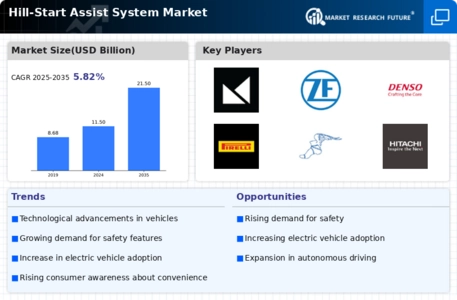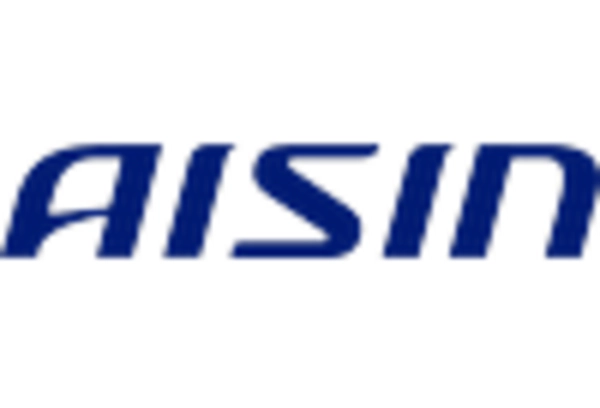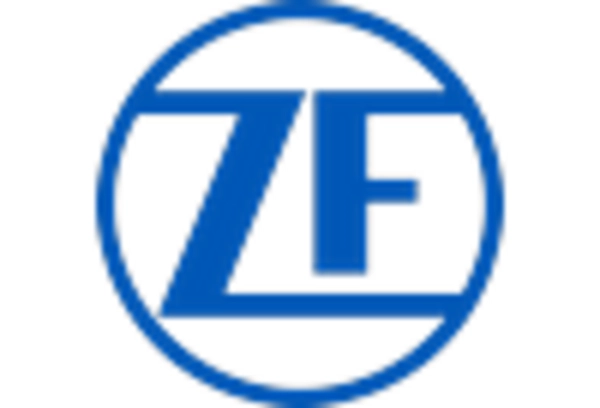Rising Urbanization and Traffic Congestion
Urbanization continues to escalate, leading to increased traffic congestion in many regions. This phenomenon significantly impacts the Hill-Start Assist System Market, as vehicles equipped with hill-start assist technology offer drivers a more manageable experience in stop-and-go traffic, particularly on inclines. The convenience provided by this system is becoming increasingly appealing to urban drivers, who often face challenging driving conditions. As urban populations grow, the demand for vehicles that facilitate easier driving in congested environments is likely to rise. This trend suggests that the Hill-Start Assist System will play a crucial role in enhancing urban mobility and driver comfort.
Technological Integration in Electric Vehicles
The rise of electric vehicles (EVs) is reshaping the automotive landscape, and the Hill-Start Assist System Market is adapting accordingly. As EVs often feature automatic transmissions, the integration of hill-start assist technology becomes essential for enhancing the driving experience. This system not only aids in preventing rollback but also complements the regenerative braking systems commonly found in EVs. The increasing adoption of electric vehicles, projected to reach a market share of over 30% by 2030, indicates a growing opportunity for hill-start assist systems to be incorporated into these vehicles, thereby expanding their market presence.
Focus on Fuel Efficiency and Emission Reduction
The automotive industry is under increasing pressure to improve fuel efficiency and reduce emissions. The Hill-Start Assist System Market is poised to benefit from this focus, as the technology can contribute to more efficient driving patterns. By preventing rollback on inclines, the system allows for smoother acceleration, which can enhance fuel economy. As regulatory bodies implement stricter emissions standards, the adoption of technologies that promote fuel efficiency, such as hill-start assist, is expected to rise. This alignment with environmental goals positions the Hill-Start Assist System as a favorable option for manufacturers aiming to meet compliance while appealing to eco-conscious consumers.
Increasing Demand for Advanced Driver Assistance Systems
The Hill-Start Assist System Market is experiencing a notable surge in demand for advanced driver assistance systems (ADAS). This trend is largely driven by the growing consumer preference for enhanced safety features in vehicles. As automakers increasingly integrate ADAS technologies, the Hill-Start Assist System becomes a critical component, ensuring smoother vehicle operation on inclines. According to recent data, the market for ADAS is projected to grow at a compound annual growth rate of approximately 10% over the next five years. This growth is indicative of a broader shift towards automation and safety in the automotive sector, positioning the Hill-Start Assist System as a vital player in this evolving landscape.
Consumer Awareness and Education on Vehicle Safety Features
Consumer awareness regarding vehicle safety features is on the rise, significantly influencing the Hill-Start Assist System Market. As drivers become more informed about the benefits of advanced safety technologies, the demand for vehicles equipped with hill-start assist systems is likely to increase. Educational campaigns and marketing efforts by automotive manufacturers are playing a pivotal role in highlighting the advantages of such systems, particularly in enhancing safety during challenging driving conditions. This growing awareness is expected to drive sales and adoption rates, further solidifying the position of hill-start assist systems within the broader automotive safety framework.



















Leave a Comment